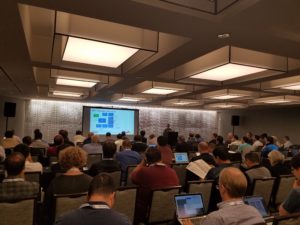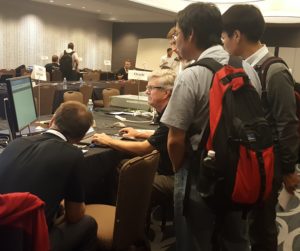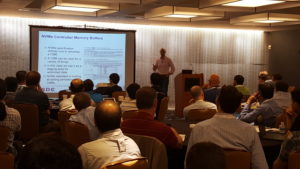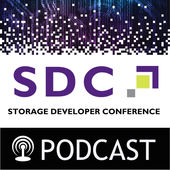Reviews are in for the 20th Storage Developer Conference (SDC) and they are thumbs up! The 2017 SDC was the largest ever- expanding to four full days with seven keynotes, five SNIA Tutorials, and 92 sessions. The SNIA Technical Council, who oversees conference content, compiled a rich agenda of 18 topic categories  focused on Read More
focused on Read More
Category: SMB3
SMB3 – These Questions Rock!
SNIA Storage Developer Conference-The Knowledge Continues
SNIA’s 18th Storage Developer Conference is officially a success, with 124 general and breakout sessions; Cloud Interoperability, Kineti c Storage, and SMB3 plugfests; ten Birds-of-a-Feather Sessions, and amazing networking among 450+ attendees. Sessions on NVMe over Fabrics won the title of most attended, but Persistent Memory, Object Storage, and Performance were right behind. Many thanks to SDC 2016 Sponsors, who engaged attendees in exciting technology discussions.
c Storage, and SMB3 plugfests; ten Birds-of-a-Feather Sessions, and amazing networking among 450+ attendees. Sessions on NVMe over Fabrics won the title of most attended, but Persistent Memory, Object Storage, and Performance were right behind. Many thanks to SDC 2016 Sponsors, who engaged attendees in exciting technology discussions.
For those not familiar with SDC, this technical industry event is designed for a variety of storage technologists at various levels from developers to architects to product managers and more. And, true to SNIA’s commitment to educating the industry on current and future disruptive technologies, SDC content is now available to all – whether you attended or not – for download and viewing.
 You’ll want to stream keynotes from Citigroup, Toshiba, DSSD, Los Alamos National Labs, Broadcom, Microsemi, and Intel – they’re available now on demand on SNIA’s YouTube channel, SNIAVideo.
You’ll want to stream keynotes from Citigroup, Toshiba, DSSD, Los Alamos National Labs, Broadcom, Microsemi, and Intel – they’re available now on demand on SNIA’s YouTube channel, SNIAVideo.
All SDC presentations are now available for download; and over the next few months, you can continue to download SDC podcasts which combine audio and slides. The first podcast from SDC 2016 – on hyperscaler (as well as all 2015 SDC Podcasts) are available here, and more will be available in the coming weeks.
SNIA thanks all its members and colleagues who contributed to make SDC a success! A special thanks goes out to the SNIA Technical Council, a select group of acknowledged industry experts who work to guide SNIA technical efforts. In addition to driving the agenda and content for SDC, the Technical Council oversees and manages SNIA Technical Work Groups, reviews architectures submitted by Work Groups, and is the SNIA’s technical liaison to standards organizations. Learn more about these visionary leaders at http://www.snia.org/about/organization/tech_council.
And finally, don’t forget to mark your calendars now for SDC 2017 – September 11-14, 2017, again at the Hyatt Regency Santa Clara. Watch for the Call for Presentations to open in February 2017.
Podcasts Bring the Sounds of SNIA’s Storage Developer Conference to Your Car, Boat, Train, or Plane!
SNIA’s Storage Developer Conference (SDC) offers exactly what a developer of cloud, solid state, security, analytics, or big data applications is looking for – rich technical content delivered in a no-vendor bias manner by today’s leading technologists. The 2016 SDC agenda is being compiled, but now you can get a “sound bite” of what to expect by downloading SDC podcasts via iTunes, or visiting the SDC Podcast site at http://www.snia.org/podcasts to download the accompanying slides and/or listen to the MP3 version.
can get a “sound bite” of what to expect by downloading SDC podcasts via iTunes, or visiting the SDC Podcast site at http://www.snia.org/podcasts to download the accompanying slides and/or listen to the MP3 version.
Each podcast has been selected by the SNIA Technical Council from the 2015 SDC event, and include topics like:
- Preparing Applications for Persistent Memory from Hewlett Packard Enterprise
- Managing the Next Generation Memory Subsystem from Intel Corporation
- NVDIMM Cookbook – a Soup to Nuts Primer on Using NVDIMMs to Improve Your Storage Performance from AgigA Tech and Smart Modular Systems
- Standardizing Storage Intelligence and the Performance and Endurance Enhancements It Provides from Samsung Corporation
- Object Drives, a New Architectural Partitioning from Toshiba Corporation
- Shingled Magnetic Recording- the Next Generation of Storage Technology from HGST, a Western Digital Company
- SMB 3.1.1 Update from Microsoft
Eight podcasts are now available, with new ones added each week all the way up to SDC 2016 which begins September 19 at the Hyatt Regency Santa Clara. Keep checking the SDC Podcast website, and remember that registration is now open for the 2016 event at http://www.snia.org/events/storage-developer/registration. The SDC conference agenda will be up soon at the home page of http://www.storagedeveloper.org.
Enjoy these great technical sessions, no matter where you may be!
A Deep Dive into the SNIA Storage Developer Conference – The File Systems Track
SNIA Storage Developer Conference (SDC) 2015 is two weeks away, and the SNIA Technical Council is finalizing a strong, comprehensive agenda of speakers and sessions. Wherever your interests lie, you’re sure to find experts and topics that will expand your knowledge and fuel your professional development!
For the next two weeks, SNIA on Storage will highlight exciting interest areas in the 2015 agenda. If you have not registered, you need to! Visit www.storagedeveloper.org to see the four day overview and sign up.
Year after year, the File Systems Track at SDC provides in depth information on the latest technologies, and 2015 is no exception. The track kicks off with Vinod Eswaraprasad, Software Architect, Wipro, on Creating Plugin Modules for OpenStack Manila Services. He’ll discuss his work on integrating a multi-protocol NAS storage device to the OpenStack Manila service, looking at the architecture principle behind the scalability and modularity of Manila services, and the analysis of interface extensions required to integrate a typical NAS head.
Ankit Agrawal and Sachin Goswami of TCS will discuss How to Enable a Reliable and Economic Cloud Storage Solution by Integrating SSD with LTFS. They will share views on how to integrate SSD as a cache with a LTFS tape system to transparently deliver the best benefits for Object Base storage, and talk about the potential challenges in their approach and best practices that can be adopted to overcome these challenges.
Jakob Homan, Distributed Systems Engineer, Microsoft, will present Apache HDFS: Latest Developments and Trends. He’ll discuss the new features of HDFS, which has rapidly developed to meet the needs of enterprise and cloud customers, and take a look at HDFS at implementations and how they address previous shortcomings of HDFS.
James Cain, Principal Software Architect, Quantel Limited, will discuss a Pausable File System, using his own implementation of an SMB3 server (running in user mode on Windows) to demonstrate the effects of marking messages as asynchronously handled and then delaying responses in order to build up a complete understanding of the semantics offered by a pausable file system.
Ulrich Fuchs, Service Manager, CERN, will talk about Storage Solutions for Tomorrow’s Physics Projects, suggesting possible architectures for tomorrow’s storage implementations in this field, and showing results of first performance tests done on various solutions (Lustre, NFS, Block Object storage, GPFS ..) for typical application access patterns.
Neal Christiansen, Principal Development Lead, Microsoft, will present Support for New Storage Technologies by the Windows Operating System, describing the changes being made to the Windows OS, its file systems, and storage stack in response to new evolving storage technologies.
Richard Morris and Peter Cudhea of Oracle will discuss ZFS Async Replication Enhancements, exploring design decisions around enhancing the ZFS send and ZFS receive commands to transfer already compressed data more efficiently and to recover from failures without re-sending data that has already been received.
J.R. Tipton, Development Lead, Microsoft, will discuss ReFS v2: Cloning, Projecting, and Moving Data File Systems, presenting new abstractions that open up greater control for applications and virtualization, covering block projection and cloning as well as in-line data tiering.
Poornima Gurusiddaiah and Soumya Koduri of Red Hat will present Achieving Coherent and Aggressive Client Caching in Gluster, a Distributed System, discussing how to implement file system notifications and leases in a distributed system and how these can be leveraged to implement a client side coherent and aggressive caching.
Sriram Rao, Partner Scientist Manager, Microsoft, will present Petabyte-scale Distributed File Systems in Open Source Land: KFS Evolution, providing an overview of OSS systems (such as HDFS and KFS) in this space, and describing how these systems have evolved to take advantage of increasing network bandwidth in data center settings to improve application performance as well as storage efficiency.
Richard Levy, CEO and President, Peer Fusion, will discuss a High Resiliency Parallel NAS Cluster, including resiliency design considerations for large clusters, the efficient use of multicast for scalability, why large clusters must administer themselves, fault injection when failures are the nominal conditions, and the next step of 64K peers.
Join your peers as well – register now at www.storagedeveloper.org. And stay tuned for tomorrow’s blog on Cloud topics at SDC!
Benefits of RDMA in Accelerating Ethernet Storage Q&A
At our recent live Webcast “Benefits of RDMA in Accelerating Ethernet Storage Connectivity” experts from Emulex, Intel and Microsoft had an insightful discussion on the ways RDMA is having an impact on Ethernet storage. The live event was attended by nearly 200 people and feedback was overwhelming positive with several attendees thanking us for our vendor neutral presentation and one attendee commenting that it was, “Probably the most clearly comprehensible yet comprehensive webinar I’ve attended in some time.” If you missed the Webcast, it’s now available on demand. We did not have time to get to everyone’s questions, so as promised, below are answers to all of them. If you have additional questions, please ask them in the comments section in this blog and we’ll get back to you as soon as possible.
Q. Is RDMA over RoCEv2 in production?
A. The IBTA released the RoCEv2 Specification in September 2014. In order to support that specification changes may be required across the RDMA stack, including firmware, drivers & operating systems. Schedules for implementation of that specification will vary by operating system. For example, the OpenFabrics Alliance (OFA) has not released an Open Fabrics Enterprise Distribution (OFED) version that implements that standard yet, although it is in process now. Once OFA completes their OFED stack implementation, the Linux distribution vendors will then incorporate and support the updated OFED stack. Implementations provided prior to full OFA and Distro vendor support would be preliminary, potentially incompatible with the OFED release, and require confirmation by the distro vendor with regard to the nature/level of support they would be providing
Q. I would have liked a list of Windows applications that take advantage of SMB Direct – both in a Hyper-V host or bare metal.
A. In Windows, any file-based application can make use of SMB3 and SMB Direct due to the native file-based programming interface support. No application changes are required. For certain enterprise applications such as Hyper-V and SQL Server, SMB3 is officially supported, and more information can be found in the product catalog at www.microsoft.com.
Q. Are there any particular benefits in using one network protocol over another for SMB Direct/RDMA (iWARP vs. RoCE vs. IB)?
A. There are no hard and fast rules; any adapter or protocol can be suitable for many scenarios. Of the Ethernet-based protocols we considered in today’s webcast
- iWARP offers the benefit of operation over TCP with its reliability and routability, well-suited to a broad range of installed infrastructure.
- RoCE offers a lightweight, efficient protocol when a DCB-enabled switched fabric is available. RoCE, however, is not routable.
- RoCEv2 offers similar properties to RoCE, with the possibility to scale to larger routed and DCB-enabled fabrics.
Q. Who are the vendors offering iWARP capable RNICs?
A. Chelsio Communications has production iWARP adapters today, and both Intel and Qlogic have publicly committed to future iWARP controllers.
Q. How much testing has been done with SMB3, and in particular SMB direct, over WAN connections?
A. The SMB2 protocol was originally designed to adapt to WAN scenarios, and supports a credit-based management of large amounts of data to be outstanding, to make best use of WAN-type long pipes. The SMB3 protocol retains these design attributes, and the SMB Direct protocol also supports similar deep pipelining. The iWARP protocol, being layered on standard TCP, is well suited to such deployments, and RoCE WAN adapters are potentially available. Please contact the respective technology vendors for information on any available testing results.
Q. I love a future webcast for RDMA enabled distributed filesystems.
A. Thanks for the suggestion! We’re always looking for ideas for future webcasts and SNIA-ESF will consider this as a potential follow-on.
Q. Is Live Migration the scenario where “packet size” is 1MB?
A. All SMB Direct scenarios have workloads that range anywhere up to 8MB. For large file copies, most SMB3 clients request from 1MB to 8MB per operation, for Hyper-V live migration, transfers are typically similar, during the bulk transfer phase.
Q. SMB3 is being compared to FC for enterprise. If Ethernet based protocols are of interest, wouldn’t FCoE give the same performance as FC (same stack) vs. SMB3?
A. SMB3 with SMB Direct enables many workloads not possible with Fibre Channel over Ethernet, and performance comparisons are therefore difficult. Perhaps another SNIA webcast could investigate this!
Q. Regarding your SMB direct example with lots of small operations, how do you deal with the overhead of registering and unregistering buffers for the RDMA operations?
A. As answered later in the session, the registration and unregistration is not a protocol matter, but in the case of the Windows implementation, it is strictly performed for the specific buffers of each operation, which is critical for security, data integrity, and system protection. The standard “Fast Register Work Request” method is used, and careful implementation has shown that the overhead does not negatively impact performance, even for small I/O (4KB/operation). Check out Jose Barreto’s blog, which contains many benchmark results.
Q. But isn’t Live Migration done in 1MB “chunks”? So not “small” I/Os?
A. As answered later in the session, Hyper-V Live Migration is done in several phases, the first phase is the initial bulk copy of memory, done in large chunks, but immediately after it a second phase of copying individual pages which were dirtied by the live-running VM is performed. These operations are typically 4KB. Note: The faster the initial phase goes, the less work there is in this second phase, but in both phases, the faster, the better, and RDMA accelerates both.
Q. Are iSER and iWARP alternatives to one another?
A. iWARP is an RDMA protocol, and iSER is a mapping of iSCSI to iWARP, as well as RoCE/InfiniBand.
Q. What’s Intel’s roadmap for RoCE and/or iWARP?
A. Intel is committed to iWARP and plans to incorporate it in future server chipsets and SOCs. See http://www.intel.com/content/www/us/en/ethernet-products/accelerating-ethernet-iwarp-video.html for more information.
Q. Is there any other Transport being used other than IB to create a reliable transport for RoceV2? Puristically it is possible?
A. RoCE was developed to leverage Infiniband as much as possible. For that reason, the Infiniband transport was chosen when the RoCE standard was developed. As the RoCEv2 standard was developed, the underlying Infiniband network protocol was replaced with IPv4 / IPv6 in order to provide the layer 3 routability and UDP to provide stateless encapsulation (and indication) of the Infiniband transport header that was retained. While it may be possible to develop a reliable transport to replace Infiniband, the RoCE standards body has elected not to go that route as of this writing.
Upcoming Plugfests at SDC
This year’s SNIA Storage Developer Conference (SDC) will take place in Santa Clara, CA Sept. 15-18. In addition to an exciting agenda with great speakers, there is an opportunity for vendors to participate in SNIA Plugfests. Two Plugfests that I think are worth noting are: SMB2/SMB3 and iSCSI.
These Plugfests enable a vendor to bring their implementations of SMB2/SMB3 and/or iSCSI to test, identify, and fix bugs in a collaborative setting with the goal of providing a forum in which companies can develop interoperable products. SNIA provides and supports networks and infrastructure for the Plugfest, creating a collaborative framework for testing. Plugfest participants work together to define the testing process, assuring that objectives are accomplished.
Still Time to Register
Great news! There is still time to register. Setup for the Plugfest begins on September 13, 2014 and testing begins on the September 14th.
Register here for the SMB2/SMB3 Plugfest
Register here for the iSCSI Plugfest
What to Expect at a Plugfest
Learn more about what takes place at the Plugfests by watching the video interview of Jeremy Allison, Co-Creator of Samba, as he candidly talks about what to expect at an SDC Plugfest.
Learn more about the Plugfest registration process. If you have additional questions, please contact Arnold Jones (arnold@snia.org).